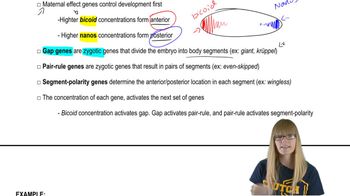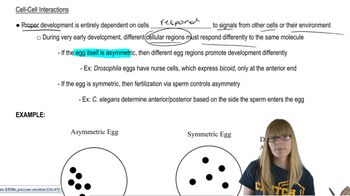The homeotic mutation Antennapedia causes mutant Drosophila to have legs in place of antennae and is a dominant gain-of-function mutation. What are the properties of such mutations? How does the Antennapedia gene change antennae into legs?
Table of contents
- 1. Introduction to Genetics51m
- 2. Mendel's Laws of Inheritance3h 37m
- 3. Extensions to Mendelian Inheritance2h 41m
- 4. Genetic Mapping and Linkage2h 28m
- 5. Genetics of Bacteria and Viruses1h 21m
- 6. Chromosomal Variation1h 48m
- 7. DNA and Chromosome Structure56m
- 8. DNA Replication1h 10m
- 9. Mitosis and Meiosis1h 34m
- 10. Transcription1h 0m
- 11. Translation58m
- 12. Gene Regulation in Prokaryotes1h 19m
- 13. Gene Regulation in Eukaryotes44m
- 14. Genetic Control of Development44m
- 15. Genomes and Genomics1h 50m
- 16. Transposable Elements47m
- 17. Mutation, Repair, and Recombination1h 6m
- 18. Molecular Genetic Tools19m
- 19. Cancer Genetics29m
- 20. Quantitative Genetics1h 26m
- 21. Population Genetics50m
- 22. Evolutionary Genetics29m
14. Genetic Control of Development
Developmental Patterning Genes
Problem 13
Textbook Question
The Drosophila homeotic mutation spineless aristapedia (ssᵃ) results in the formation of a miniature tarsal structure (normally part of the leg) on the end of the antenna. What insight is provided by (ssᵃ) concerning the role of genes during determination?
 Verified step by step guidance
Verified step by step guidance1
Understand the concept of homeotic mutations: These are mutations in genes that control the development of body structures, causing one body part to develop characteristics of another. In this case, the spineless aristapedia (ssᵃ) mutation causes a leg-like structure to form on the antenna.
Recognize the role of homeotic genes: Homeotic genes are responsible for determining the identity of body segments and structures during development. The ssᵃ mutation provides evidence that these genes are crucial in specifying the correct identity of body parts.
Analyze the ssᵃ mutation: The mutation suggests that the gene affected by ssᵃ is involved in the determination process, where cells decide their developmental fate. This mutation disrupts the normal determination process, leading to the transformation of antenna cells into leg-like cells.
Consider the implications for gene regulation: The ssᵃ mutation highlights the importance of precise regulation of homeotic genes. Misregulation can lead to developmental abnormalities, as seen in the formation of tarsal structures on the antenna.
Conclude the insight provided: The ssᵃ mutation demonstrates that genes play a critical role in determination by specifying the identity and fate of cells during development. It underscores the importance of genetic control in ensuring proper body structure formation.
 Verified video answer for a similar problem:
Verified video answer for a similar problem:This video solution was recommended by our tutors as helpful for the problem above
Video duration:
1mPlay a video:
Was this helpful?
Key Concepts
Here are the essential concepts you must grasp in order to answer the question correctly.
Homeotic Genes
Homeotic genes are crucial in determining the identity of body segments during development. They encode transcription factors that regulate the expression of other genes, guiding the formation of specific structures in the correct locations. Mutations in these genes can lead to the transformation of one body part into another, as seen in the Drosophila spineless aristapedia mutation.
Recommended video:
Guided course

Segmentation Genes
Gene Regulation
Gene regulation refers to the mechanisms that control the expression of genes, determining when and where specific genes are activated or silenced. This process is essential for proper development, as it ensures that genes are expressed in the right cells at the right times. In the case of the ssᵃ mutation, misregulation leads to the inappropriate formation of leg structures on the antenna.
Recommended video:
Guided course

Review of Regulation
Morphogen Gradients
Morphogen gradients are concentration gradients of signaling molecules that provide positional information to cells during development. Cells interpret these gradients to determine their fate and develop into specific structures. The spineless aristapedia mutation highlights how disruptions in these gradients can lead to abnormal structures, emphasizing the importance of spatial information in gene expression and development.
Recommended video:
Guided course

Cell-cell interactions
Related Videos
Related Practice
Textbook Question
685
views


